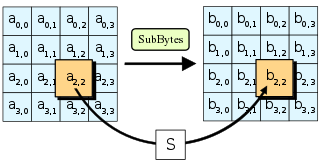
The Advanced Encryption Standard (AES), also known by its original name Rijndael, is a specification for the encryption of electronic data established by the U.S. National Institute of Standards and Technology (NIST) in 2001.
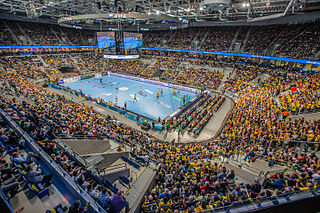
Handball is a team sport in which two teams of seven players each pass a ball using their hands with the aim of throwing it into the goal of the other team. A standard match consists of two periods of 30 minutes, and the team that scores more goals wins.
The Real Irish Republican Army or Real IRA (RIRA), also called the New IRA (NIRA) after a merger in 2012, is a dissident Irish republican paramilitary group which aims to bring about a united Ireland. It formed in 1997 following a split in the Provisional IRA by dissident members, who rejected the IRA's ceasefire that year. Like the Provisional IRA before it, the Real IRA sees itself as the only rightful successor to the original Irish Republican Army and styles itself as simply "the Irish Republican Army" in English or Óglaigh na hÉireann in Irish. It is an illegal organisation in the Republic of Ireland and designated as a proscribed terrorist organisation in the United Kingdom and the United States.

Volleyball is a popular team sport in which two teams of six players are separated by a net. Each team tries to score points by grounding a ball on the other team's court under organized rules. It has been a part of the official program of the Summer Olympic Games since Tokyo 1964.

The Third Battle of Ypres, also known as the Battle of Passchendaele, was a campaign of the First World War, fought by the Allies against the German Empire. The battle took place on the Western Front, from July to November 1917, for control of the ridges south and east of the Belgian city of Ypres in West Flanders, as part of a strategy decided by the Allies at conferences in November 1916 and May 1917. Passchendaele lay on the last ridge east of Ypres, 5 mi (8.0 km) from the German controlled Roulers junction of the Bruges (Brugge) to Kortrijk railway, the main supply route of the German 4th Army. The next stage was an advance to a line from Thourout to Couckelaere.
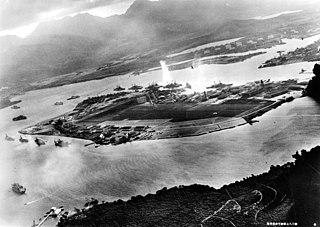
The attack on Pearl Harbor was a surprise military strike by the Imperial Japanese Navy Air Service upon the United States against the naval base at Pearl Harbor in Honolulu, Hawaii on Sunday morning, December 7, 1941. The attack led to the United States' formal entry into World War II the next day. The Japanese military leadership referred to the attack as the Hawaii Operation and Operation AI, and as Operation Z during its planning.

The Battle of Midway was a decisive naval battle in the Pacific Theater of World War II that took place between 4 and 7 June 1942, only six months after Japan's attack on Pearl Harbor and one month after the Battle of the Coral Sea. The United States Navy under Admirals Chester W. Nimitz, Frank Jack Fletcher, and Raymond A. Spruance defeated an attacking fleet of the Imperial Japanese Navy under Admirals Isoroku Yamamoto, Chūichi Nagumo, and Nobutake Kondō near Midway Atoll, inflicting devastating damage on the Japanese fleet that proved irreparable. Military historian John Keegan called it "the most stunning and decisive blow in the history of naval warfare", while another naval historian, Craig L. Symonds, called it "one of the most consequential naval engagements in world history, ranking alongside Salamis, Trafalgar, and Tsushima, as both tactically decisive and strategically influential."

The Battle of Leyte Gulf is considered to have been the largest naval battle of World War II and, by some criteria, possibly the largest naval battle in history, with over 200,000 naval personnel involved. It was fought in waters near the Philippine islands of Leyte, Samar, and Luzon, from 23–26 October 1944, between combined American and Australian forces and the Imperial Japanese Navy (IJN), as part of the invasion of Leyte, which aimed to isolate Japan from the countries it had occupied in Southeast Asia which were a vital source of industrial and oil supplies.

Forwards are the players on an association football team who play nearest to the opposing team's goal, and are therefore most responsible for scoring goals.
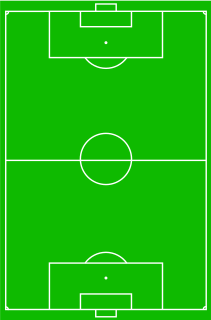
A midfielder is an association football position. Midfielders are generally positioned on the field between their team's defenders and forwards. Some midfielders play a disciplined defensive role, breaking up attacks, and are otherwise known as defensive midfielders. Others blur the boundaries, being more mobile and efficient in passing: they are commonly referred to as deep-lying midfielders, play-makers, box-to-box, or holding midfielders. The number of midfielders on a team and their assigned roles depends on the team's formation; the collective group of these players on the field is sometimes referred to as the midfield.
In the sport of association football, a defender is an outfield player whose primary role is to prevent the opposing team from scoring goals.
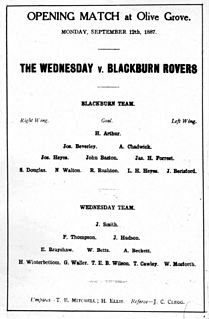
In association football, the formation describes how the players in a team generally position themselves on the pitch. Association football is a fluid and fast-moving game, and a player's position in a formation does not define their role as rigidly as for, for instance, a rugby player, nor are there episodes in play where players must expressly line up in formation. Nevertheless, a player's position in a formation generally defines whether a player has a mostly defensive or attacking role, and whether they tend to play towards one side of the pitch or centrally.

In the sport of association football, each of the 11 players on a team is assigned to a particular position on the field of play. A team is made up of one goalkeeper and ten outfield players who fill various defensive, midfield, and attacking positions depending on the formation deployed. These positions describe both the player's main role and their area of operation on the pitch.
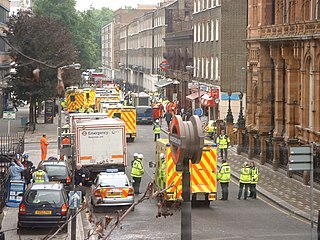
The 7 July 2005 London bombings, often referred to as 7/7, were a series of coordinated Islamist terrorist suicide attacks in London, England, that targeted commuters travelling on the city's public transport system during the morning rush hour.
In the Dungeons & Dragons role-playing game, game mechanics and die rolls determine much of what happens. These mechanics include:

The September 11 attacks were a series of four coordinated terrorist attacks by the Islamic terrorist group al-Qaeda against the United States on the morning of Tuesday, September 11, 2001. The attacks killed 2,996 people, injured over 6,000 others, and caused at least $10 billion in infrastructure and property damage. Additional people died of 9/11-related cancer and respiratory diseases in the months and years following the attacks.
The Bandaranaike Airport attack was an assault by the Liberation Tigers of Tamil Eelam (LTTE) on Bandaranaike International Airport, on July 24, 2001. The attack was one of the boldest the LTTE mounted during its war with the Sri Lankan government, and had a profound impact on the country's military, economy, and airline industry.

The 2008 Mumbai attacks were a series of terrorist attacks that took place in November 2008, when 10 members of Lashkar-e-Taiba, an Islamic terrorist organisation based in Pakistan, carried out 12 coordinated shooting and bombing attacks lasting four days across Mumbai. The attacks, which drew widespread global condemnation, began on Wednesday 26 November and lasted until Saturday 29 November 2008. At least 174 people died, including 9 attackers, and more than 300 were wounded.

Attack on Titan is a Japanese manga series both written and illustrated by Hajime Isayama. It is set in a fantasy world where humanity lives within territories surrounded by three enormous walls that protect them from gigantic man-eating humanoids referred to as Titans.

On 3 June 2017, a terrorist vehicle-ramming and stabbing took place in London, England. A van was deliberately driven into pedestrians on London Bridge before crashing on the south bank of the River Thames. Its three occupants then ran to the nearby Borough Market area and began stabbing people in and around restaurants and pubs. The attackers were Islamists inspired by Islamic State (ISIS). They were shot dead by Metropolitan Police officers and were found to be wearing fake explosive vests. Eight people were killed and 48 were injured, including members of the public and four unarmed police officers who attempted to stop the assailants.















